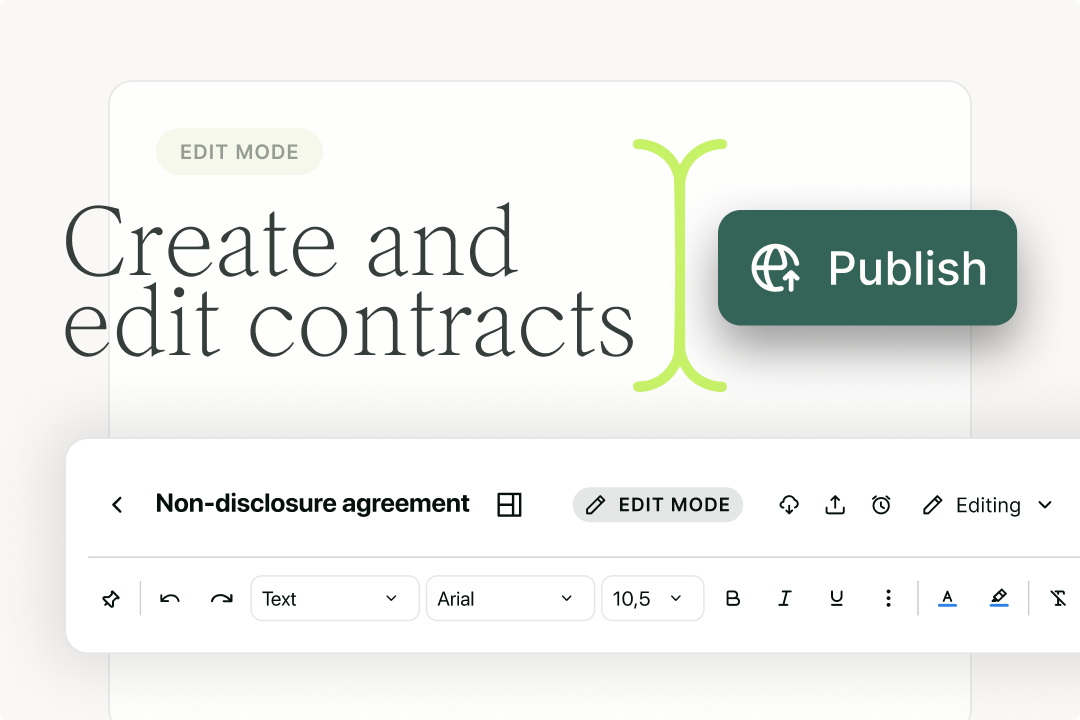Solutions
Customer Support
Resources


Fast-growth businesses are producing legal agreements at scale, leaving many legal teams buried in low-value work, according to our latest Tech GC Report. With extensive negotiations, poorly integrated tools, and repetitive admin to contend with, it’s no surprise that legal teams are seeking a more efficient way to create contracts.
Could standardized contracts be the answer? If so, how do you standardize a contract? Let’s find out in this Juro explainer.
A standardized contract is a legal agreement between two or more parties whereby one party has set out contractual terms that are mostly non-negotiable. Also known as standard form contracts, these legal documents offer the counterparty little to no scope for requesting changes, and they are typically used for low-risk and low-value contracts that are distributed at scale.
Why? Well, contract standardization can reduce costs, improve productivity and mitigate risk for your business by reducing the need for the drafting and negotiation of individual contract terms.

Since Software as a Service agreements are already quite complex, covering everything from liability caps, to data use provisions, to indemnities and much more, too much scope for customization can prove chaotic and create a lot of risk.
If terms deviate from the standard form, legal will quickly lose sight of what’s being agreed and the risk to which the company is exposed.
Therefore, creating a robust standardized SaaS agreement can mitigate risk, reduce back and forth in negotiations and result in a better experience for both sides. This is also the case for other contracts, like software license agreements.
Vendor agreements set out the terms and conditions of purchase, and they are often distributed at scale, particularly for fast-growth companies. The content and process behind vendor agreements need to be consistent, otherwise, the challenges that come from managing these contracts can compound.
If a company wants to quickly and repeatedly generate, distribute and agree vendor agreements, it will benefit from a standardized contract that can be rolled out at scale.
Master Service Agreements (MSAs) outline any terms that govern the commercial relationship between a business and its client, and they are commonplace in high velocity sales organizations. Without standardized MSAs, contract creators (for example, salespeople) may send out contracts that include unapproved terms. These might be discounts that finance wouldn’t allow, data use provisions that compliance would reject, or indemnity caps that would terrify legal. For this reason, standardization for MSAs is a popular choice.
Option agreements outline the Ts and Cs that give a counterparty a right (but not an obligation) to buy an asset. Since option agreements are effectively HR contracts and relate closely to brand and values, it is important that these agreements are consistent. If not, employees might assume that the business is unprofessional and disorganized – or worse, that it cares as little for its existing staff as it does for new employees. By standardizing your agreements, you can rest assured that each and every contract is designed to impress.
You now know what standardization means, and when it is most commonly used in contracts. But what are the broad benefits of contract standardization, and how can it benefit your organization? Let’s discuss:
{{quote1}}
If you're keen to leverage the many benefits of contract standardization for your business, and you want a contract tool to help you do so, hit the button below.
Juro embeds contracting in the tools business teams use every day, so they can agree and manage contracts end-to-end - while legal stays in control.

Finally, how do you actually standardize a legal agreement? Here are some hints and tricks to consider when creating a standard contract template to be rolled out at scale:
Before creating a standardized contract, ask yourself ‘why’ you have decided to improve the contract process in the first place.
Usually, the answer is to deliver more benefits for both parties. The counterparty will have a better contract experience, and therefore a positive impression of your business. For your business, it will streamline the overall process, easing negotiations and saving time as your company continues to scale. A win-win situation for all.
This ease will then set the tone for the relationship between you and your customer; deliver a positive experience and increase the chance of repeat business, making it a worthwhile effort.
Want to get to ‘yes’ faster? Nail your contract template first.
When standardizing a contract, reflect on previous agreements to identify any pain points for your team. Ask yourself:
If the answer to any of these questions is yes, then optimize your contract for signing by resolving these. Often, the simplest edits and the smallest details can make the biggest difference, so building the perfect template around these is a no-brainer!
Legal design studies suggest that traditional contracts often overwhelm users due to poor design, and that, by rectifying this, you can improve the user experience dramatically.
Legal design is not just a buzzword. User-centric design can have a huge impact on how quickly counterparties sign contracts. Through linking, layering, and tables, you can present the contract’s most important terms and cut through the noise to make contracts more digestible and human.

This, paired with cutting out the legal jargon and replacing it with plain language, will make the entire contract process more efficient and enjoyable. That means more contracts signed, and faster.
When standardizing your contracts, be sure to focus on the experience your end-user will have when reading the contract – and consider what impact this might have on your commercial relationship.
Within all contracts, you should opt for brevity. This includes complex contracts such as SaaS agreements. When standardizing an agreement, you should aim to create a contract template that covers all of the necessary details and components of the agreement - without the masses of dense, jargon-filled text that can scare potential customers off.
By putting the details that matter at the forefront of your template, you can communicate important information more effectively and reduce the time that your business and legal teams waste on drafting, proofing, and negotiating contracts.
Gone are the days where contracts had to be monotone, dull and jargon-rich. Why not inject some personality into your legal agreements, and give your clients a better understanding of who they will be working with?
The truth is, the more visually appealing your contract is, the more likely it is to get signed. By reinforcing your branding and enriching your contracts with logos, images, graphs, and GIFs, you could improve the user experience of the other party and present your business as a more organized, exciting, and human prospect to work with. Talk about selling yourself.
To bring branding and cool illustrations into your standard form contracts, find a dynamic editor that supports these forms of media. Check out how this looks in Juro below.
When standardizing contracts, you might need fallback positions for certain agreements. Usually, if an agreement is above a certain value, you are more likely to be willing to negotiate certain terms within these.
This negotiation is made significantly easier with a contract collaboration platform that uses conditional logic since you can embed fallback positions within the template itself and empower teams to negotiate contract terms without the need for legal involvement.
By codifying these deviations within your templates, you can provide legal visibility and approval rights without adding friction. At the top level, contracts will be standardized, but with enough flexibility to keep deals moving.
As most in-house legal teams know all too well, there will be certain non-negotiables within your contracts that you want to protect at all costs. It is in any business’s interests to bend on a few terms as possible. This is why certain standardized contracts, such as MSAs, are sometimes kept in a separate document and linked to the order form - to encourage people to sign the contract with less scrutiny.

Fortunately, certain legal provisions typically won’t change. For example, if an MSA says that data is kept in servers based in the EU, it’s unlikely that this will differ on a contract-by-contract basis.
Standardizing your documents means you can dedicate more time to personalizing each agreement. Make sure your employees feel like individuals instead of another cog in the machine, receiving the same mass-produced template.
This is especially important for contracts like option agreements, where a personal touch can result in a more positive employee experience.
Traditionally, contracts that are created and managed across several different systems - typically Word, email, and DocuSign - suffer version control issues and data loss, with changes (and the audit trails behind them) lost in this transition across platforms.
An automated workflow, with your legal team defining the template and approving any changes through negotiation, is much safer, more efficient, and more likely to deliver a standardized contract every time.

If you’re looking to achieve standardization for your legal agreements, the following features will help you to achieve a frictionless workflow:

From time to time, you might not be able to avoid departing from your standard terms – and even from your fallback positions.
A contract with your biggest customer might be negotiated offline, in a room, perhaps even with external counsel. In that case, make sure you have an escape route – being able to export to Word is always useful if you absolutely have to.
If your contract workflow is supercharged with all these features, it will enable commercial and business teams to standardize agreements, leading to less risk, more certainty, and – hopefully – happiness on both sides of the contract.
Is managing routine contracts at scale a pain point for your business? If your contract process is out of control, with multiple systems and a lack of visibility both pre- and post-signature, try Juro. Juro is an all-in-one contract automation platform that helps visionary legal counsel and the teams they enable to agree and manage contracts in one unified workspace. Hit the button below to find out more.
.avif)
The Juro knowledge team is an interdisciplinary group of Juro's brightest minds. Our knowledge team incorporates different perspectives from a range of knowledgeable stakeholders at Juro, including our legal engineers, customers success specialists, legal team, executive team and founders. This breadth and depth of knowledge means we can deliver high-quality, well-researched, and informed content, leaning on our internal subject matter experts and their unique experience in the process.
Juro's knowledge team is led by Tom Bangay, Sofia Tyson, and Katherine Bryant, but regularly features other contributors from across the business.

Juro embeds contracting in the tools business teams use every day, so they can agree and manage contracts end-to-end - while legal stays in control.
Book your demo